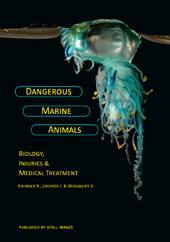The waters surrounding the Maldives have an international reputation for spectacular diving that entices hordes of visitors to the country every year.
Much of the credit for this goes to the prolific marine life, which ensures even the sharks are friendly – a flailing tourist is a difficult meal when all a shark has to do is open its mouth for the fish to swim inside.
But when injuries at the fins, spines, teeth and tentacles of marine life do occur, local medical facilities have proven ill-prepared to deal with them.
When local marine biologist Verena Wiesbauer Ali visited an island doctor following a nasty sting from a Pelagia panopyra (Purple Jellyfish), he asked her why she had eaten one.
“I had swam through a soup of jellyfish and the itching was so bad I couldn’t sleep,” she recalls.
The doctor treated the symptoms with an IV and some anti-histamines, but later told her there was little literature available on the country’s dangerous or toxic marine life.
“His diagnosis was ‘fish stinger’,” she says. “I felt sympathetic so I took in a photo of the jellyfish the next day and the doctor began to ask a lot of other questions.”
Much of the literature Verena found was in German, and the treatments were varied. Conventional wisdom, such as applying vinegar to a jellyfish wound to deactivate the poison, was not always the case: “If you apply vinegar to the sting of a Portugese Man o’ War, it can have the opposite effect,” Verena discovered.
Researching further she did find a great many local stories along the lines of “‘there’s an animal this shape and this wide, and if you touch it your arm will fall off.'”
Assembling a team of doctors and marine biologists, including Dr Jens Lindner and Dr Reinhard Kilinger, she decided to write the Maldives’ first reference to dangerous, venomous and poisonous marine animals.
“We felt the need for a doctor’s reference that gives a detailed description of symptoms and recommendations for medical treatment,” she says, adding that one important inclusion was a Dhivehi reference dictionary for the local names of different species and dangerous seafood, such as sea urchins.
Beyond medical applications, Verena says the authors tried to make the book accessible “for anyone coming into contact with the sea, from snorkelers and divers to tourists and marine biologists.”
It includes information and treatment instructions for creatures like lion fish (“from a group known as scorpion fish that have quite strong venom – the display they make by spreading their fins is to show prey ‘I’m poisonous'”), sharks (“there are 35 species in the Maldives, including tiger sharks which can be more aggressive”,) and sting rays.
“Sting rays lie on the sea floor feeding on mollusks,” Verena explains. “They will move away from a person, but if stepped on they have venomous spines in their tail that can be fatal, as with [Australian TV personality] Steve Irwin. Most people are hit in the shin, but the spine is serrated and it normally has to be pushed through the limb; you can’t pull it, although now we can operate it out.”
Even seemingly-harmless surgeon fish can cause painful injuries: “They have a blade at the base of their tail fin.”
At a presentation on the book to doctors and nurses at Indira Gandhi Memorial Hospital (IGMH) today, president of the Maldivian Medical Association Dr Azeez Yoosuf noted that while Male’s roads caused more injuries than the country’s waters, “there is a lot of inappropriate treatment of injuries caused by marine creatures.”
“We come across island hospitals where wounds caused by sting rays have been nicely stitched up, but because of the toxins the wound becomes necrotic. It’s better to keep the wound open, but the tendency is to stitch it,” he explains.
Surgeon fish injuries were surprisingly common, he added. “You can safely swim through a school of surgeon fish. But curious tourists sometimes try to pat them and get a big cut on their hand, which can become a problem because the [tail] can be covered in a lot of slime.”
As for the tremendously poisonous stonefish, “we don’t have the anti-venom, it’s only available in Australia. We just treat the pain.”
Despite their fearsome reputation, shark attacks were very rare, he said.
“The only shark bite I’ve seen was on someone who caught one and tried to get the fishhook out by putting his hand in the [live] shark’s mouth.”
The traditional treatment for jellyfish stings, he noted, was “hot urine or alcohol.”

“Dangerous Marine Animals – Biology, Injuries & Medical Treatment” (Kikinger, Lindner, Wiesbauer-Ali 2009) is printed and published in the Maldives and is available directly from the publisher Atoll Images, Ma. Shah, Dhidhi Goalhi, Male’ (3341643).